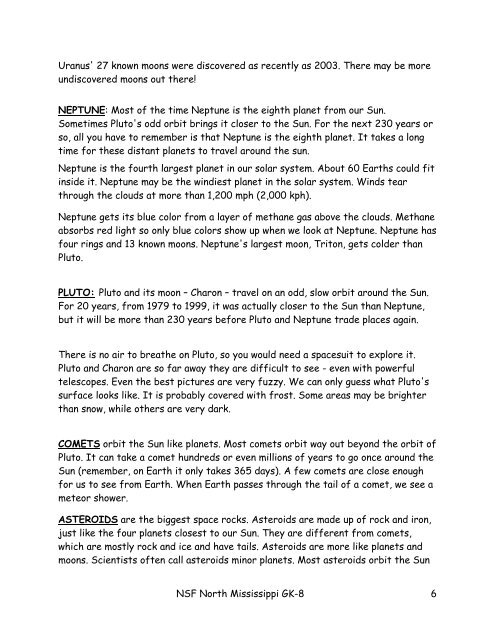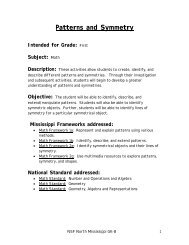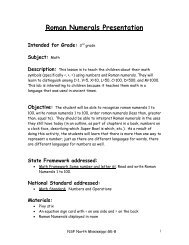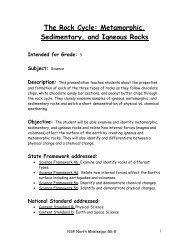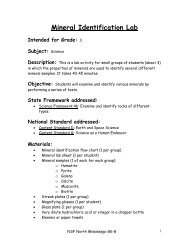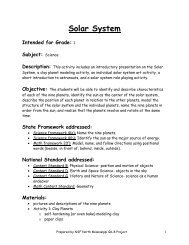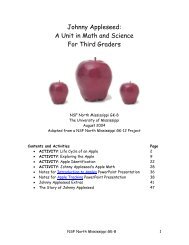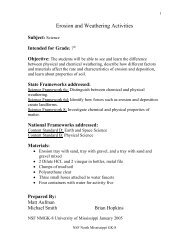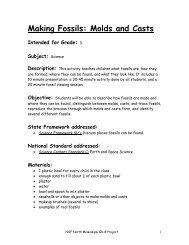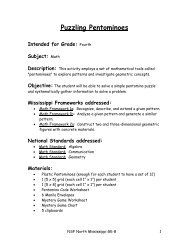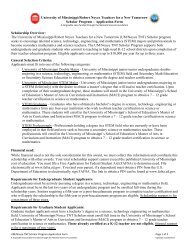Planets around the Sun - The Center for Mathematics and Science ...
Planets around the Sun - The Center for Mathematics and Science ...
Planets around the Sun - The Center for Mathematics and Science ...
You also want an ePaper? Increase the reach of your titles
YUMPU automatically turns print PDFs into web optimized ePapers that Google loves.
Uranus' 27 known moons were discovered as recently as 2003. <strong>The</strong>re may be moreundiscovered moons out <strong>the</strong>re!NEPTUNE: Most of <strong>the</strong> time Neptune is <strong>the</strong> eighth planet from our <strong>Sun</strong>.Sometimes Pluto's odd orbit brings it closer to <strong>the</strong> <strong>Sun</strong>. For <strong>the</strong> next 230 years orso, all you have to remember is that Neptune is <strong>the</strong> eighth planet. It takes a longtime <strong>for</strong> <strong>the</strong>se distant planets to travel <strong>around</strong> <strong>the</strong> sun.Neptune is <strong>the</strong> fourth largest planet in our solar system. About 60 Earths could fitinside it. Neptune may be <strong>the</strong> windiest planet in <strong>the</strong> solar system. Winds tearthrough <strong>the</strong> clouds at more than 1,200 mph (2,000 kph).Neptune gets its blue color from a layer of methane gas above <strong>the</strong> clouds. Methaneabsorbs red light so only blue colors show up when we look at Neptune. Neptune hasfour rings <strong>and</strong> 13 known moons. Neptune's largest moon, Triton, gets colder thanPluto.PLUTO: Pluto <strong>and</strong> its moon – Charon – travel on an odd, slow orbit <strong>around</strong> <strong>the</strong> <strong>Sun</strong>.For 20 years, from 1979 to 1999, it was actually closer to <strong>the</strong> <strong>Sun</strong> than Neptune,but it will be more than 230 years be<strong>for</strong>e Pluto <strong>and</strong> Neptune trade places again.<strong>The</strong>re is no air to brea<strong>the</strong> on Pluto, so you would need a spacesuit to explore it.Pluto <strong>and</strong> Charon are so far away <strong>the</strong>y are difficult to see - even with powerfultelescopes. Even <strong>the</strong> best pictures are very fuzzy. We can only guess what Pluto'ssurface looks like. It is probably covered with frost. Some areas may be brighterthan snow, while o<strong>the</strong>rs are very dark.COMETS orbit <strong>the</strong> <strong>Sun</strong> like planets. Most comets orbit way out beyond <strong>the</strong> orbit ofPluto. It can take a comet hundreds or even millions of years to go once <strong>around</strong> <strong>the</strong><strong>Sun</strong> (remember, on Earth it only takes 365 days). A few comets are close enough<strong>for</strong> us to see from Earth. When Earth passes through <strong>the</strong> tail of a comet, we see ameteor shower.ASTEROIDS are <strong>the</strong> biggest space rocks. Asteroids are made up of rock <strong>and</strong> iron,just like <strong>the</strong> four planets closest to our <strong>Sun</strong>. <strong>The</strong>y are different from comets,which are mostly rock <strong>and</strong> ice <strong>and</strong> have tails. Asteroids are more like planets <strong>and</strong>moons. Scientists often call asteroids minor planets. Most asteroids orbit <strong>the</strong> <strong>Sun</strong>NSF North Mississippi GK-8 6


